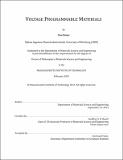Voltage programmable materials
Author(s)
Bauer, Uwe, Ph.D. Massachusetts Institute of Technology
DownloadFull printable version (8.164Mb)
Other Contributors
Massachusetts Institute of Technology. Department of Materials Science and Engineering.
Advisor
Geoffrey S. D. Beach.
Terms of use
Metadata
Show full item recordAbstract
The physical and chemical properties of nanoscale materials derive largely from structure and composition at interfaces. The possibility to electrically modify these interfacial characteristics would provide a powerful means to control material properties. Of particular recent scientific and technological interest are metal/metal-oxide bilayers, in which properties as varied as catalytic activity, charge and spin transport, ionic exchange, mechanical behavior, thermal conductivity, and magnetism all depend sensitively on oxygen stoichiometry and defect structure at the metal/metal-oxide interface. The possibility to dynamically control interface characteristics through electric-field-induced oxygen transport and electrochemical interface reactions paves the way towards voltage control of these properties in solid-state devices. Here, we focus on ferromagnetic metal/metal-oxide bilayers that exhibit strong perpendicular magnetic anisotropy derived from interfacial oxygen hybridization. In these materials, we directly observe, in situ voltage-driven oxygen migration at room temperature and show that electrical switching of the interfacial oxidation state allows for voltage control of magnetic properties to an extent never before achieved through conventional magneto-electric coupling mechanisms. By engineering the electrode and metal-oxide layers for efficient ionic exchange and transport, we improve the response time by six orders of magnitude and switch perpendicular magnetic anisotropy at the millisecond timescale. Based on this magneto-ionic coupling mechanism we demonstrate a printer-like system to reversible pattern magnetic properties and realize a prototype nonvolatile memory device in which voltage-controlled domain wall traps facilitate electrical bit selection in a magnetic nanowire register. Moreover, we report on voltage control over electronic transport properties in the same bilayer structures and show that solid-state switching of interface oxygen chemistry provides a path towards voltage-gating the wide range of phenomena governed by metal/oxide interfaces.
Description
Thesis: Ph. D., Massachusetts Institute of Technology, Department of Materials Science and Engineering, February 2015. This electronic version was submitted by the student author. The certified thesis is available in the Institute Archives and Special Collections. Cataloged from student-submitted PDF version of thesis. Includes bibliographical references (pages 211-223).
Date issued
2015Department
Massachusetts Institute of Technology. Department of Materials Science and EngineeringPublisher
Massachusetts Institute of Technology
Keywords
Materials Science and Engineering.